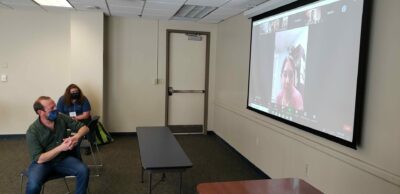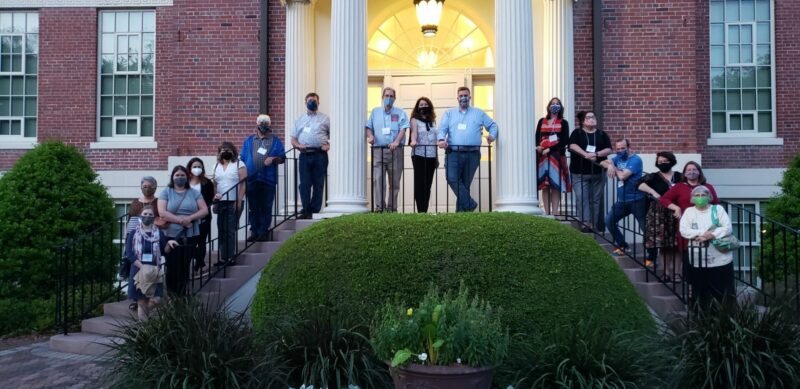Join Meeting? Conferencing During COVID-19-Part 2
16 September 2021 – Rebecca Bush
Editors’ Note: This is the second of a pair of posts about lessons learned from virtual conferences during the COVID-19 pandemic.
One of the attractions of attending professional conferences is the opportunity to network with colleagues, old and new. The past year has made me acutely aware of the sense of community built through these experiences, whether in-person or virtual. Each conferencing format has its benefits and drawbacks, and people may prefer different options during different seasons of their lives.

The most successful hybrid sessions at the 2021 Georgia Association of Museums conference proved to be roundtables, where small-group discussion flowed easily between in-person and virtual attendees. One in-person facilitator monitored the virtual chat function. Photo credit: Rebecca Bush.
The intangible benefits of in-person gatherings can be heard not only in the chatter and laughter of conference receptions and dinners but also in the projects and collaborations that develop as a direct result of conference interactions. These post-session conversations and spontaneous chats benefit our professional practice and creativity by allowing us to engage with fresh perspectives while asking nitty-gritty questions and discovering serendipitous connections, an opportunity that even the best-written journal article cannot emulate. As someone who has long loved to travel, being in a different city and engaging in a focused, time-limited experience away from home helps put me in a conference state of mind. For a few days, I can set aside research or paperwork to think big, learn from the best, and renew my belief in the meaningful change public historians can facilitate. In the best instances, conference travel supports my mental health—a statement I’d be hard-pressed to make about a platform that lent its name to a condition now listed on health websites.
However, I know that my experiences are far from universal, and virtual conferencing has been a boon to many during the pandemic. In addition to providing greater access to public historians who find conference travel difficult or impossible, virtual conferencing can enable community volunteers and advocates to participate in conferences they would not physically travel to. In the summer of 2019, I jumped at the opportunity to submit a session proposal with several local non-public historians for the 2020 NCPH annual meeting in Atlanta, a mere 100 miles from our community. Though we were unable to convert our session for the 2020 virtual meeting, the opportunity to present with one of those dedicated local history advocates in 2021 was a joy, one that never would have happened if we gathered in Utah as planned. It was also wonderful to “see” and meet many new people virtually; in planning the April 2021 Georgia Association of Museums conference, an event that prides itself on its affordability for staff and volunteers at the state’s small museums, my colleagues and I observed people signing up for the virtual component who had never engaged with us before. Familiar faces were also present, and greetings could be easily exchanged via Zoom chats. In other words, that vital community-building still happened, albeit in different ways.
As we enter a new period of professional development opportunities, public historians should take this opportunity to consider how we establish place and community, both in the virtual conference world and at in-person gatherings where we continue to navigate questions of masking, distancing, vaccination status, and personal comfort. It can sometimes feel as though the rigidly structured format of virtual conferences leaves little room for spontaneity, but trial and error has yielded continuous progress in this regard. Virtual lunches and mixers at the National Council on Public History (NCPH) 2021 annual meeting made the most of their setting, encouraging attendees to participate in home scavenger hunts and other activities that foregrounded the virtual experience. The smart utilization of breakout rooms to encourage small-group discussion made conference sessions feel much more intimate, often creating more opportunities for meaningful conversation than in crowded hotel ballrooms. One standby of conferences in the Before Times—outdoor walking tours, are poised for a resurgence in popularity at in-person conferences, given their low cost and ability to gather groups in outdoor spaces.

Outdoor venues helped promote event safety and participant comfort at the 2021 Georgia Association of Museums conference while still encouraging visitors to enjoy the host city of Statesboro, Georgia. Photo credit: Rebecca Bush.
Perhaps the most important lesson is the most obvious: don’t try too hard to make uniquely in-person experiences virtual or vice versa. Strive to create experiences for each, using attendees’ feedback, that makes people want to attend both. Priya Chhaya wrote earlier this year about the importance of identifying the purpose of virtual gatherings to craft formats that best meet each gathering’s needs. This sense of purpose should accompany all professional development gatherings, whether virtual or in-person. Are we traveling all these miles to annual conferences because it’s expected of us or because these events truly serve our professional practice and personal well-being? Smart data gathering could even help organizations better determine how to allocate precious staff resources between in-person and virtual professional development programs.
As for me, after being involved at nearly every level of planning or attending a virtual conference over the past year and a half, you’ll hopefully find me enjoying an evening chat around a hotel fire pit at my next conference. My face will also continue to pop up in Zoom squares for virtual presentations that I would attend in-person if only I had unlimited time and money. Though the pandemic forced us all to absorb a great deal of technical know-how in precious little time, the early chaos will pay dividends in our virtual conferencing for years to come.
~Rebecca Bush is curator of history and exhibitions manager at the Columbus Museum in Georgia.



